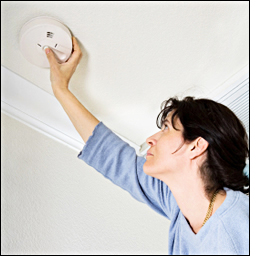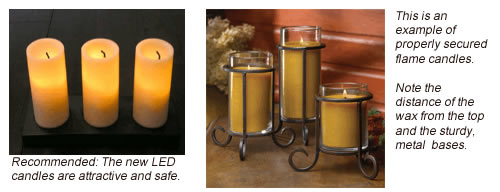Home Fire Safety
Use this Home Fire Safety Checklist as a guide when assessing your home’s fire safety preparedness.
Fire safety starts in your driveway. Make sure you have a clearly marked address sign at your driveway. If you have a long driveway or more than one house at the end of a driveway, place additional signage on your home so that we can find you in case of an emergency.
Smoke and Carbon Monoxide Alarms

Working smoke and carbon monoxide (CO) alarms are the most important thing you can have for fire safety in your home. Smoke alarms detect products of combustion and smoke and CO alarms detect the deadly odorless gas carbon monoxide. In Oregon, all homes are required to have a smoke alarm between each sleeping area and the rest of the home. If the home has an attached garage and/or any fuel burning appliance (wood stove, fireplace, gas stove, heater, or hot water heater) it is also required to have a CO alarm between each sleeping area and the potential source. It is suggested to have detectors on each level of the home as well as in each bedroom. Although not required, special alarms with a nuisance reset are available for locations such as kitchens, garages, near wood stoves, etc. where incidental false alarms may occur but early warning is also beneficial. Maintenance is simple but important as most false alarms come from the lack thereof. Test monthly via test button, change batteries yearly (unless 10 year lithium type) and vacuum periodically to clean out any dust particles that can affect sensitivity–it’s that easy.
The Red Cross has a free smoke alarm program for low-income seniors. Please contact them at 503-528-5783 for more information.
Fire Escape Plan
It is so important to know two ways out of each room in your home. People of all ages should have a plan of what to do in case of a fire. If you have children or seniors living in your home, you should pay special attention to practicing your escape plans that specifically address those family members. The following are some things to remember when you practice your fire escape plan.
- Walk through the main escape route several times. Try it when it is light and also in the dark with your eyes closed. You can memorize the number of steps and obstacles or turns. If you bump into something like a piece of furniture, move it to clear the path.
- Plan a second way out of each room. If the main route is blocked by fire or smoke, you need to have a back up plan. If bedroom windows are too high for safe jumping, you could look into a few options, perhaps you could buy a rope ladder to keep at a window in each bedroom.
- If you must go through a smoke filled hallway, you need to get as low to the ground to crawl on your hands and knees. Make sure to keep your head low to avoid breathing smoke.
- Agree to a meeting plan, some plan that you can call or get help coming if you haven’t already. For more information please call us at 536-2935.
- Once you are outside stay out, never go back into the house once you are outside.
Evacuation: Because we live in a rural area, you need to also have a plan if a fire were to strike the wild land in your neighborhood. You may not always have a lot warning before your neighborhood is asked to evacuate. You should have a list of items that are most important to you and what and where your next steps are.
Woodstoves and Fireplaces
- Use the solid fuel burning appliance safety checklist to help insure you have a safe appliance.
- New installations require a mechanical inspection by Deschutes County Planning and Development. Stove FAQ Link
- Chimneys should be inspected and cleaned every season. Creosote buildup varies greatly, depending on such things as frequency of use, how hot you burn, and dryness of the wood.
- Recommended to use a professional chimney sweep; it is safer and also worth avoiding the mess.
- Burn only clean dry wood. Don’t burn trash in your stove. (This isn’t safe and it is against the law).
- Never, ever use flammable liquids to start a fire.
- When you clean out your fireplace or wood stove, put ashes in an all metal container away from the house and never in the garbage – Embers will last for days.
Candles
- Candles are a leading cause of home fires.
- Your fire department highly recommends the new LED candles – they are much safer, are very cost effective, and they look real!
- If you do use candles, ensure they are in sturdy metal, glass or ceramic holders and placed where they cannot be easily knocked down.
- Keep candles at least 12 inches from anything that can burn.
- Keep candles out of the reach of children and pets.
- Avoid using candles in bedrooms and sleeping areas.
- Never use a candle where medical oxygen is being used. The two can combine to create a large, unexpected fire. And never, ever, ever, leave burning candles unattended!

Heating
- Space heaters should be kept at least three feet away from flammable objects-anything that will burn.
- Make sure the heater is placed on a level surface.
- Don’t use extension cords on electric heaters.
- Electric space heaters should not be used in the bathroom or where they could come in contact with water.
- Electric blankets should be always be laid out flat, never left in a bunch and you should always turn off and unplug your electric blanket before you go to sleep or leave your home.
Safety When Cooking
- Things that will burn should be kept far away from any heat source. These include the burners on your stove, your oven, the toaster, or the BBQ.
- Keep the stove stop and burners clean. A lot of grease on these areas can be a fire hazard.
- Pot handles should be turned to the side or the rear of the stove so that the pots can’t be tipped over.
- If grease catches fire, place a lid over the pan to smother the fire. If you can, safely turn off the burner. Never put water on a grease fire. It will spread the fire.
- Always pay close attention when cooking at the stove.
- When children are present, make sure to teach them that they need to stay far away from the stove and other heating appliances.
